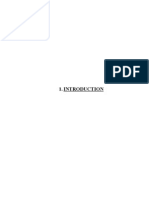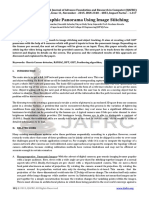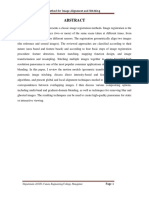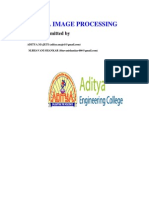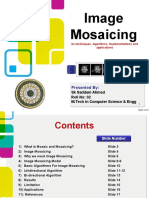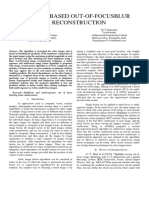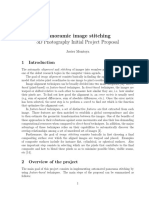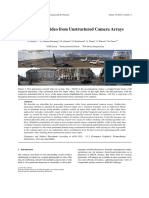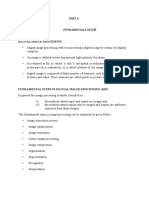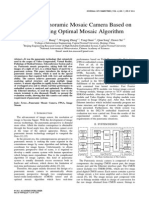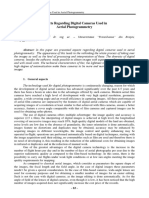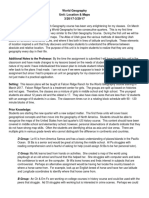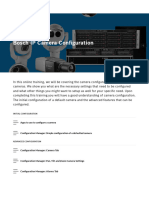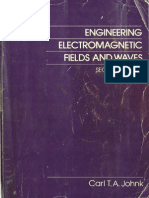Image Stitching - Comparisons and New Techniques: CITR-TR-30 October 1998
Uploaded by
Praveen Kumar VellineniImage Stitching - Comparisons and New Techniques: CITR-TR-30 October 1998
Uploaded by
Praveen Kumar VellineniComputer Science Depatrment of The University of Auckland
CITR at Tamaki Campus (http://www.tcs.auckland.ac.nz)
CITR-TR-30 October 1998
Image Stitching -
Comparisons and New Techniques
Chia-Yen Chen
1
Abstract
In this work, we are mainly dealing with the stitching of panoramic images. However,
the methods described and evaluated here can also be used for different applications in
image mosaicing.
1
The University of Auckland, Computer Science Department, CITR,
Tamaki Campus (Building 731), Glen Innes, Auckland, New Zealand
1 Introduction
Recently a specialised form of image mosaicing known as image stitching, has become increasingly
common [Shu97], especially in the making of panoramic images. Stitched images are used in applications
such as interactive panoramic viewing of images, architectural walk-through, multi-node movies and other
applications associated with modelling the 3D environment using images acquired from the real world.
Panoramic image stitching is the process performed to generate one panoramic image from a series of
smaller, overlapping images. Fig. 1 shows the main steps in producing a panoramic image.
Select position and image
acquisition method
Image registration
Image merging
Output of stitched image
Image stitching
Preprocess images
Start
Acquire images
Figure 1: The flowchart of producing a panoramic image.
In Fig. 1, the first step in the generation of a panoramic image is to select the position and acquisition of
images. In this step, a decision needs to be made on the type of resultant panoramic images. According to
the required panoramic images, different image acquisition methods are used to acquire the series of images.
After the images have been acquired, some processing might need to be applied to the images before they
can be stitched. For example, the images might need to be projected onto a surface, which can be a
mathematical surface such as a cylindrical, spherical, or planar surface. Distortions caused by the camera
lenses also need to be corrected before the images are processed further.
In this work, the process of image stitching has been divided into two steps, image registration and image
merging. During image registration, portions of adjacent images are compared to find the translations which
align the images. Once the overlapping images have been registered, they need to be merged together to form
a single panoramic image. The process of image merging is performed to make the transition between
adjacent images visually undetectable.
A panoramic image is generated after the images have been stitched. By generating panoramic images
with image stitching, the images can be acquired using a relatively inexpensive camera and the angle of view
covered by the panoramic image can be determined by the user. The stitched image can also be of higher
resolutions than a panoramic image acquired by a panoramic camera.
Our first objective is to provide a detailed understanding of the generation of panoramic images and the
steps involved in implementing an image stitcher. To achieve this goal, the three main procedures required in
the generation of panoramic images, i.e., image acquisition, image registration and image merging, are
discussed. It is also our objective to evaluate existing image stitching methods and methods given in this work
such that a quantitative indication of the performances of the various methods can be provided. It is then
possible to select methods which are suitable for panoramic image stitching based on the evaluations.
In this work, we are mainly dealing with the stitching of panoramic images. However, the methods
described here can also be adapted and applied for different applications of image mosaicing.
2 Image acquisition
Different image acquisition methods can be used to acquire input images that produce different types of
panoramic images, depending on the type of panoramic images required and the availability of equipment.
Three set-ups to acquire images for panoramic image generation are described and discussed in this
section. In the first set-up, the camera is set upon a tripod and the images are obtained by rotating the camera.
The second set-up places the camera on a sliding plate and the images are obtained by shifting the camera on
the sliding plate. The third set-up is where the camera is held in a persons hands and the person takes the
images by turning around on the same spot, or walking in a direction perpendicular to the cameras view
direction.
In all three set-ups, a still image camera has been used to take the images. The camera co-ordinate
system is shown in Fig. 2, where the Z-axis points towards the object of interest and the Y-axis passes through
the optical axis of the camera.
Y
Z
X
Camera Object of interest
Figure 2: Camera co-ordinate system.
The cameras angles of view in the horizontal and vertical directions decide each images coverage in the
horizontal and vertical directions. The angles of view are defined in Fig. 3, where the angles c and r
respectively represent the cameras angles of view in the horizontal and the vertical directions.
Y
Z
r
Z
Y
c
X X
Figure 3: The horizontal and vertical angles of view.
2.1 Acquisition by camera rotations
In this acquisition method, the tripod is set levelly at a chosen position and stays in the same position
throughout the acquisition of the images. After securing the camera on the tripod, the camera is focused on
the objects of interest and rotated with respect to the vertical axis in one chosen direction. One image is taken
with each rotation of the camera until the desired range has been covered. Fig. 4 shows the set-up of the
tripod and the camera for image acquisition by camera rotations. In an ideal set-up, the Y-axis should pass
the optical centre of the camera and there should not be any camera rotations except for the rotation about the
Y-axis between successive images.
Object of
interest
Camera
and tripod
Rotating clockwise
c
Figure 4: Camera and tripod for acquisition by camera rotations.
Each image in the series acquired for panoramic image stitching partially overlaps the previous and the
following images. The size of the overlapping region is an important factor in image stitching. As S. E.
Chen suggested in 1995, it is desirable to have 50% of the image overlap with the previous image and the other
50% of the image overlap with the following image [Che95]. A larger overlapping region allows adjacent
images to be merged more easily in the image merging step of image stitching. Fig. 5 illustrates the geometry
of two overlapping images as viewed from above. In Fig. 5, L represents the width of the acquired image and
l represents the width of overlapping region between adjacent images. The ratio of l to L is dependent upon
the angle of rotation between successive images, \, and the horizontal angle of view of the camera, c.
l
Camera
L
c
\
Figure 5: Geometry of overlapping images.
The ratio of the width of the overlapping region to the width of the image can be estimated by Eqn. 1,
l
L
L
L
.
1
]
1
1
1
]
1
1
2
1
1
2
1
2
2
2
2
tan( )
tan( )
tan( )
tan( )
(1)
However, the actual size of the overlapping region might differ from the calculated if the camera is tilted,
i.e., there is camera rotation other than the required rotation about the Y-axis. Rotations other than in the
specified direction cause problems in the image stitching and affect the quality of the resultant panoramic image.
Therefore, in the acquisition of images by camera rotation, it is undesirable to have rotations in directions other
than about the specified axis. Another factor which needs to be taken into consideration is the fact that the
objects in the real world are projected onto a 2D plane. Hence, by rotating the camera during image
acquisition, the distances between points might not be preserved.
Since the camera is rotated between successive images, the orientation of each imaging plane is different
in this acquisition method. Therefore, images acquired by this method need to be projected onto the same
surface, such as the surface of a cylinder or a sphere, before image registration can be performed.
One advantage with acquiring images by rotation is that the camera can stay in one place during the
acquisition of the series of images. Rotation of the camera does not require a large amount of measurement
and can be performed easily. However, the acquired images are not on a same surface and need to be
projected onto a same surface before being passed on to the image stitcher. As with most projections, the
quality of the images degrades after the projection. This problem is more significant when the images are
obtained using cameras with shorter focal length, or wider field of view. Nevertheless, due to the simplicity of
the set-up and the operations, this method is preferred in acquiring images for the generation of panoramic
images.
2.2 Acquisition by camera translations
In this acquisition method, the camera is shifted in a direction parallel to the imaging plane. On a
smaller scale, the camera can be mounted onto a sliding plate to achieve the translations. The camera and the
sliding plate are placed directly in front of the objects of interest and an image is taken with each translation of
the camera until the series of images cover the desired range. Fig. 6 shows the set-up of this method, where
the camera is aligned with the sliding plate so that the imaging plane is parallel to the orientation of the sliding
plate.
Direction of translation
d
l
t
Camera
L
c
Figure 6: Geometry for image acquisition by camera translations.
Given the camera translation, t, the distance between camera and object of interest, d, and the cameras
horizontal angle of view, c, the ratio of the overlapping region to the whole image can be estimated by Eqn. 2,
l
L
t
d
1
2
2
tan( )
.
(2)
Nevertheless, the actual size of the overlapping region between successive images is determined by the
accuracy in setting up the camera. In acquiring images by translation, it is important to ensure that the image
planes are parallel to the direction of camera translations. Otherwise, the size of the objects in the images
varies as the camera is shifted, causing problems in image stitching.
One disadvantage of this method is that the required translation, t, increases as the distance between the
camera and the object of interest, d, increases, if the acquired images are to have the same sized overlapping
region. Therefore, acquiring images when the object of interest is far away from the camera is more difficult
due to the magnitude of required translations. Furthermore, since the acquired images are all on the same
plane, the panoramic images obtained from images acquired by translation does not provide the feeling of
looking into a 3D environment as in the case for the panoramic images obtained from images acquired by
rotation.
2.3 Acquisition by a hand held camera
This acquisition method is comparatively easy to perform, the user simply holds the camera and takes
images of his/her surroundings by either rotating on the same spot or moving in a predefined direction roughly
parallel to the image plane. However, images acquired by this method can be difficult to stitch, due to the
amount of unwanted camera rotation or translation during the acquisition of images.
In the case of the user turning with the camera to obtain the images, the user acts as the tripod of the
camera in Section 2.1. However, rather than rotating about, or approximately about the vertical axis of the
camera, there are inaccuracies in the alignment of the rotating axis with the vertical axis. It is also difficult to
control the angles rotated between successive images. Therefore, the sizes of the overlapping regions between
adjacent images have a greater variation than for images acquired by a camera mounted on a tripod.
When the user holds up the camera and moves in one direction to acquire the images, the user acts as the
sliding plate in acquisition by translation in Section 2.2. However, in this situation, it is even more difficult to
control the distance shifted between each image and keep each image on the same imaging plane. Therefore,
apart from the difference in the size of the overlapping regions, the image planes of the acquired images have
different orientations and cause problems in image stitching.
It is often desirable to have a larger overlapping regions between adjacent images to reduce the effects of
the above mentioned problems in acquiring images free-handed. Larger overlapping regions implies that the
camera rotations, or translations between successive images are smaller, thus reducing the amount of
inconsistencies between images.
Nevertheless, acquiring images by a hand held camera is very easy to manage and can be performed in
many locations where it might be difficult to set up equipment such as the tripod or the sliding plate. If care is
taken during the acquisition of the images, it is possible to produce panoramic images of similar quality to those
generated with images acquired by mounted cameras.
2.4 General problems in image acquisition
One of the most commonly faced problem in image acquisition is the intensity shift between adjacent
images. In an ideal case, the same region or object should have the same intensity values in adjacent images.
However, due to the variation in the lighting intensity, or the angle between the camera and the light source, the
intensity values for the same region or object are different in adjacent images. Other causes for the intensity
shift between images include the contrast adjustment done during the development of photographs, as well as
during the scanning of the photographs, both of which can be avoided if a digital camera is used to acquire the
images in the first place.
Another problem also associated with the lighting condition is the appearance of high-lights on reflective
regions, such as on regions of glasses or shining metal. The occurrence of high-light reduces the contrast in
the affected region and causes the region to be blotted out in the acquired image.
During the time needed to adjust the equipment to the next position after the acquisition of each image,
objects within the scene might have moved from their previous positions. Therefore, considerations should be
taken when movable objects are to be included in a series of images. Since it will be quite difficult to correctly
register the images, once an object in the images has moved from its firstly perceived position and orientation.
The images might also suffer from lens distortions depending on the lens used to acquire the images.
Pincushion and barrel distortion are two of the common distortions caused by the lens [Bra95, Ros82]. These
two types of distortions can be corrected by using the same lens to take an image of a grid. By using the
known parameters of the original grid, it is possible to find a transformation which maps the distorted grid in
the acquired image to the original grid. The transformation can then be applied to each of the images taken
with the same lens to correct the distortion.
3 Image registration
To form a larger image with a set of overlapping images, it is necessary to find the translations to align
the images. The process of image registration aims to find the translations to align two or more overlapping
images such that the projection from the view point through any position in the aligned images into the 3D
world is unique.
An image registration method usually consists of four main components [Bro92]. They are the feature
set, similarity measure, search set and search strategy. These four components respectively define what is
used to compare the images, how to evaluate the similarity between the images, the range of possible
transformations between the images and how to decide the next transformation for evaluation based on the
current similarity measure. By varying the contents of these four components, different registration methods
with different behaviours can be constructed.
The feature set refers to the set of features to be used in the comparison of the images. In our work, we
use the term feature to mean the characteristics defined by the colour intensity values of the image. The set
of features includes the intensity values, contours, textures and so on. A feature set must be selected for each
image registration method. The chosen features are extracted from the images and compared in the
registration of the images.
The similarity measure is a function which returns a scalar value that provides an indication of the
similarities between two features. By similarity between the features, we mean the similarity in orientation,
size and colours of the features. The intensity values of the selected feature from the images are used to
calculate the similarity measures. The values of the similarity measures are used to select transformations for
aligning the images.
The search set is a set of possible transformations for aligning the images. It contains transformations
such as horizontal or vertical translation, rotations, or other more complex transformations obtained by a
combination of translations and rotations. The transformations contained in the search set are evaluated by
the similarity measures to decide the best transformation required to align the given images.
The search strategy is the algorithm that decides how to select the next transformations from the search
set.
3.1 Basic method
Over the years, a number of image registration methods have been proposed. These methods usually
involve pattern matching to find the transformations required to align the images [Bar72, Bro92, Che97, Gon87,
Gam88, Kas90, Rit96, Ros82, Shi87, Son93]. In this section, selected components from previously proposed
methods are used to construct a simple image registration method.
The images used in this section are from the Tamaki campus of Auckland university and they are acquired
with a rotating camera set on a tripod. The camera has a focal length of 35 mm and is set in the landscape
position throughout the acquisition of the images. Since the images are obtained by camera rotation, they
have been projected onto a cylindrical surface before image registration. The series of images are registered in
a clockwise order, i.e., from left to right, using the components defined above. Fig. 7 shows an example of a
pair of adjacent images.
Since the input images are all coloured images, the averaged intensities of the red, green and blue
components of the image are used in the feature set. By using the averaged intensities of the three channels,
image registration only needs to be performed on one set of intensities, yet each of the three colour channels
contributes to the image registration process.
The similarity measure of the image registration method is defined next. The sum of the absolute
differences of the averaged intensities has been selected to be used as the similarity measure in this image
registration method.
Next, the type of transformations in the search set need to be defined. According to the image
acquisition methods used, most of the transformations between overlapping images are translations. It has
been assumed that there is negligible rotations and translations in unspecified directions during the acquisition
of the images. Therefore, the search set has been defined so that it contains only the translations in the
horizontal and vertical directions.
The search strategy we have decided to use in this image registration method is an exhaustive search
strategy which calculates the similarity measure for each transformation in the search set. In this way, the
optimal similarity measure is guaranteed to be the globally optimal measure.
Overlapping region
Figure 7: Example of input images.
In the acquisition of this series of images, the angle of rotation between successive images, \, is 15.
The horizontal angle of view of the camera, c, is 54.4. Given these two values, the ratio of the overlapping
area of this series of images is estimated to be 70% of the whole image, according to Eqn. 1. From the
estimated ratio of overlapping region, a window on the right hand side of the left image is defined to be 50% of
the width and height of the input images, to ensure that the window is within the overlapping region of the input
images.
Another point which needs to be mentioned is that the centre of the image tends to contain more
information in general, i.e., the centre regions are less likely to be of uniform intensity values. Hence by
placing the window towards the centre of the image, the similarity measures calculated from the contents in the
windows provides a more reliable indication to the actual similarity of the windows. Registering the images
on the left hand side first also means that the overlapping region between I
k
and I
k+1
is located towards the right
hand side of I
k
and the left hand side of I
k+1
. Therefore, in this work, W
k
has been defined on the right hand
side of I
k
and centred vertically in the middle of the image. Keeping the components and window properties in
mind, we now describe the image registration method in more detail.
Let I
k
be the image obtained from averaging the intensity of the red, green and blue channels of the kth
image in the sequence of input images, where k can be from 1 to the total number of images in the series of
images. Let W
k
be the mn window defined on I
k
, with the top left hand corner at position (a,b) of I
k
, as
shown in Fig. 8.
The image on the right hand side of the kth image, i.e., image I
k+1
, is transformed by a selected
transformation from the search set. A window, W
k+1
, of the same size and shape as W
k
, is defined on I
k
. The
position of W
k+1
on I
k+1
is obtained by applying the inverse of the selected transformation to (a,b).
I
k
m
W
k
(a,b)
n
Figure 8: W
k
is the m by n window at position (a,b) in I
k
.
Define W
k
on image I
k
Define W
k+1,(u,v)
Calculate S
k
(u,v)
Calculated
all possible
S
k
(u,v) ?
No
Select (u*,v*)
from S
k
(u,v)
Yes
Calculate required
translations from (u*,v*)
Start
End
Figure 9: Flowchart of steps involved in image registration.
In this method, the similarity measure between the two windows is the sum of the absolute differences of
the two windows. Therefore, the similarity measure for position (u,v), is calculated by Eqn. 3,
S u v W i j W i j
k k k u v
j
n
i
m
( , ) | ( , ) ( , )|
,( , )
+
1
1 1
.
(3)
Once the similarity measures for all of the possible positions have been calculated, the optimal matching
position, denoted by (u*,v*), is chosen by examine the magnitudes of values in S
k
. In this method it is intuitive
to choose the position which has the minimum similarity measure as the optimal matching position. The
reason is that the sum of the absolute differences of two windows has been used as the similarity measure and a
smaller difference usually implies a greater degree of similarity between the windows. Therefore, a position
(u*,v*) is selected, such that the value of the similarity measure at that position is the minimum in all of the
calculated similarity measures. That is, at the optimal position (u*,v*), the value of S
k
(u*,v*), is minimal
among {S
k
(i,j)}, as shown in Eqn. 4,
S u v S i j
k
i H m j L n
k
( , ) { ( , )}
* *
,
min
1 1
.
(4)
The transformation required to align I
k
and I
k+1
can then be obtained from (u*,v*). The steps involved in
this image registration method can be represented by the flowchart in Fig. 9. The images registered by this
method are shown in Fig. 10.
Figure 10: Registered images.
Figure 11: Registered image.
However, at times, this method may return the wrong translations due to various reasons. One of these
reasons is that the position where the similarity measure for the windows is globally minimal, has been assumed
to provide the translations for the optimal alignment of the images. In the case where the intensities between
adjacent images differ significantly, the absolute differences of the averaged intensities may not be a good
indication of the similarity of the images. Fig. 11 shows how two adjacent images with visible intensity
differences between them are registered by this method. From the images, it is obvious that the image has not
been correctly registered in the vertical direction.
3.2 Registration using a different feature set
One approach to avoid the misalignment caused by the differences in the intensity between adjacent
images is to choose a feature which is not as dependent upon the intensity as the averaged intensity used in the
basic method. A feature that has such property is the set of edges in an image. The set of edges is also a
good feature to be used in registering images, since a lot of the information, such as the size, shape and
orientation of objects, are conveyed by the edges. The intensity shift between adjacent images also does not
affect the edge images significantly.
In this image registration method, the binary edge image of the image is used as the feature set to avoid the
misalignment. The similarity measure, search set and the search strategy remain as before so that the effect of
varying the feature set can be observed.
To generate the binary edge map, a suitable edge operator needs to be selected [Kle96]. Since our aim is
to reduce the effect of the differences in the intensities of the images, a simple edge operator that provides
reasonable edge images for the images suffices. The edge image generated by the edge operator is converted
into a binary image so that only the significant edges remain in the feature set.
After comparing the binary edge images generated by the Sobel, Prewitt and Kirsch operators, it has been
found that the Sobel operators are able to provide the binary edge images more suited to our purpose. Fig. 12
shows the images registered using binary edge images generated by the Sobel operators as the feature set. By
comparing Figs. 11 and 12, it can be seen that the correct translations required to align the images have been
obtained by using the binary edge image in the feature set. Therefore, using the binary edge image in the
feature set can improve the accuracy of image registration by reducing the adverse effect of the intensity
differences in adjacent images.
Figure 12: Registered images.
3.3 Registration using different similarity measures
Three similarity measures are investigated in this section, the squared differences, correlation product and
the standard deviation of the differences of the intensity values in the defined windows. According to the
similarity measures used, different criteria are used to determine the optimal matching position.
The first similarity measure is the sum of the square differences of the intensity values in the windows, W
k
and W
k+1
[Shi87]. It has been assumed that lower similarity measures indicate the windows are more alike.
According to this assumption, the optimal translations required to align the images are indicated by the position
where the similarity measure is the global minimum. Fig. 13 shows the image registered by choosing the
position with the minimum value of similarity measures.
Figure 13: Image registered using sum of squared differences.
The second similarity measure is the sum of the correlation product of W
k
and W
k+1
. With this similarity
measure, it is assumed that a higher similarity measure indicates a better match. The image registered using
the product of the windows as the similarity measure is shown in Fig. 14.
Figure 14: Image registered using sum of product.
The third similarity measure to be investigated is the standard deviation of the intensity differences
between the windows. This similarity measure is propose to deal with the situation where there is an intensity
shift between adjacent images. It has been thought that the intensity shift between adjacent images can result
in large differences for the windows at the optimal matching position, thus causing incorrect translations to be
returned. However, in the same situation, the standard deviation of the intensity differences for matching
windows may be quite small, since the intensity value differs with the corresponding position in W
k+1
by
approximately the same amount in each position of W
k
. Therefore, by using the standard deviation of the
intensity values as the similarity measure, the image registration method can be made more tolerant to the
intensity shifts between adjacent images. In this method, we assume that if two windows are similar, then the
intensity differences of the windows should be uniform, resulting in smaller standard deviation. Fig. 15
shows the images registered this using the standard deviation of the intensity differences as the similarity
measure.
Figure 15: Images registered using standard deviation of differences.
Despite the intensity differences between the images, the images have been well aligned, as seen in Fig. 15.
Therefore, using the standard deviation of the intensity differences as the similarity measure is one possibility
of avoiding misalignment caused by the intensity differences between the images.
3.4 Registration by restricting the search set
For images acquired to generate a panoramic image, the rotations or translations of the camera between
the acquisitions of successive image should be quite similar, if not constant. Hence the transformations
required to align each pair of these images should also be quite similar, making it possible to estimate the next
transformation from the previously obtained transformations.
Let (u
k-1
*,v
k-1
*) denote the position with the optimal similarity measure for images I
k-1
and I
k
, where
images I
k-1
and I
k
, are both from a series of images acquired for the generation of a panoramic image.
According to the assumption about the acquisition of images, the position with the optimal similarity measure
for images I
k
and I
k+1
is within a neighbourhood of the position with the optimal similarity measure for images
I
k-1
and I
k
. Therefore, we can use the previously obtained matching position to define a region, within which
the position with the optimal similarity measure for images I
k
and I
k+1
is contained.
(a)
(b)
Figure 16: Image registered by (a) initial method and (b) restricting the search set.
From Fig. 16, it can be seen that by restricting the search set during image registration, more accurate
alignment can be obtained. Therefore, for image registration in the generation of panoramic images, it is
advantageous to improve the accuracy of image registration by restricting the search set.
3.5 Registration with step search strategy
A few step search algorithms have been proposed for estimations of motion field in MPEG images
[Tzi94]. The advantage of using a step search algorithm is that the required number of calculations for
similarity measures can be reduced dramatically. In this section, we look at an image registration method
which uses a 2D binary search to locate the position with the optimal similarity measure, (u
k
*,v
k
*).
In this search strategy, only five positions are evaluated for their respective similarity measures in each
iteration of the search. The five positions include a centre point and four points respectively in the north, east,
south and west of the centre point. Initially, the centre point, (u
0
,v
0
), is centred in the region being searched.
The distances between the centre point and the four other points are the step sizes. Initially, the vertical step
size, s
u,0
, is half the distance between the centre point and the top border, and the horizontal step size, s
v,0
, is
half the distance between the centre point and the left border.
The search starts by evaluating the similarity measure for the window located at each of the five initial
positions, i.e., (u
0
,v
0
), (u
0
-s
u,0
,v
0
), (u
0
,v
0
+s
v,0
), (u
0
+s
u,0
,v
0
) and (u
0
,v
0
-s
v,0
). After obtaining five similarity
measures, S
k
(u
0
,v
0
), S
k
(u
0
-s
u,0
,v
0
), S
k
(u
0
,v
0
+s
v,0
), S
k
(u
0
+s
u,0
,v
0
) and S
k
(u
0
,v
0
-s
v,0
), the position with the optimal
similarity measure (u
1
,v
1
) is chosen as the centre point for the next search iteration. The similarity measure is
optimised by minimising the sum of the absolute differences between W
k
and W
k+1
. After determining the next
centre position,(u
1
,v
1
), the vertical and horizontal steps, s
u,0
and s
v,0
, are halved to give the next steps, s
u,1
and
s
v,1
,
When both step sizes reach 1, the similarity measures of eight positions around the centre point are
evaluated to determine the position with the optimal similarity measure. Since the step size is reduced by half
in each iteration, the search algorithm converges to a solution very quickly. The image registered using the
step search algorithm is shown in Fig. 17.
Figure 17: Image registered using step search.
In Fig. 17, it can be seen that the images have been well registered by this registration method.
Nevertheless, at times, using a step search strategy may miss out the position of the globally optimal similarity
measure and return a position with locally optimal similarity measure due to the fact that not all of the positions
within the search region are evaluated. Therefore, even though the use of step search algorithms significantly
reduces the required number of calculations, it may not be practical to use step search algorithms in the process
of image registration. However, it might be worthwhile to investigate the use of step search algorithms in
providing an estimation of the optimal position.
3.6 Combination of methods
In this section, we briefly describe a few image registration methods that are constructed by varying the
contents of two or more components in the initial image registration method. This is done so that the
constructed image registration methods may have the combined benefits of the selected components.
3.6.1 Registration with binary edge image and restricted search set
This image registration method uses the binary edge image as the feature set and a restricted
neighbourhood as the search set. The similarity measure is the absolute differences of the pixel values in the
binary edge images and the search strategy is an exhaustive search over the defined search set.
With this combination, the chance of misalignment can be reduced by limiting the search to a defined
neighbourhood, within which the optimal overlapping position is guaranteed to occur. By using the binary
edge image as the feature set, we can increase the image registration methods tolerance to the intensity
differences between the images to be registered.
3.6.2 Registration with restricted search set and different similarity measures
The registration methods discussed in this section uses the averaged intensity values as the feature set, but
with different similarity measures. The search set is restricted and the search strategy is the exhaustive search
over all possible translations.
The similarity measures in this section are calculated from the squared intensity differences, the
correlation product of the intensities, and the standard deviation of the intensity differences. By keeping the
other components the same, it is possible to observe the effect of varying the similarity measure while limiting
the search to a defined neighbourhood.
3.6.3 Registration with restricted search set and step search
To improve the accuracy of the image registration method that uses a step search as the search strategy,
we restrict the search set for the method. The feature set is the averaged intensity or the binary edge image.
The similarity measure is either the absolute differences of the intensities, or the standard deviation of the
intensity differences.
Recall that the a possible cause of error in using a step search algorithm is that the local optima can make
the algorithm converge towards the wrong solution. Therefore, a restricted search set is used in this section, to
lower the chance of the algorithm converging towards a local optimum away from the position with the globally
optimal similarity measure.
To further increase the chance of returning the correct translations for aligning images, we need reliable
similarity measures. From the previous sections, it has been found that the binary edge image, combined with
the absolute differences of the pixel values, provides a good indication of the similarity between the features
being compared. Therefore, in one image registration method, we use the binary edge image as the feature set,
the sum of absolute differences as the similarity measure, with a restricted search set and the binary step search
algorithm. It has also been found that when the averaged intensity is used in the feature set, the standard
deviation of the intensity differences between the compared features is a good similarity measurement.
Therefore, an image registration method using the averaged intensity as the feature set, the standard deviation
of the intensity differences as the similarity measure, a restricted search set, and the binary step search strategy
is also constructed.
3.7 Comparison of methods
In this section, the images registered by every image registration method mentioned in this section are
used to evaluate the performance of each method quantitatively.
Each pair of images in the input series of images is manually aligned so that the images appear to be best
aligned according to human perception. The translations thus obtained are used as the best possible
translations for aligning pairs of images and act as the standard for evaluating the performances of different
image registration methods.
Table 1 shows the manually acquired translations for the images and Fig. 18 shows the series of images
after they have been joined according to the translations shown in Table 1.
Image no. 1-2 2-3 3-4 4-5 5-6 6-7 7-8
Vert.trans. -5 3 1 -1 -1 2 2
Horiz. trans. 156 154 160 158 167 159 163
Table 1: Manually obtained translations.
Figure 18: Manually registered images.
To simplify the reference to different image registration methods, Table 2 provides the numberings for all
of the image registration methods mentioned in Section 3. The methods are referenced to by their numbers
hereafter.
Method Description
1 Basic image registration method (Section 3.1)
2 Uses binary edge image as feature space (Section 3.2)
3 Uses squared intensity difference as similarity measure (Section 3.3)
4 Uses correlation as similarity measure (Section 3.3)
5 Uses standard deviation of intensity differences as similarity measure (Section
3.3)
6 Uses restricted search space (Section 3.4)
7 Uses a step search algorithm as search strategy (Section 3.5)
8 Uses restricted search space and binary edge image as feature space (Section
3.6.1)
9 Uses restricted search space and squared intensity differences as similarity
measure (Section 3.6.2)
10 Uses restricted search space and correlation as similarity measure (Section
3.6.2)
11 Uses restricted search space and standard deviation of intensity differences as
similarity measure (Section 3.6.2)
12 Uses restricted search space, binary edge image as feature space and a step
search algorithm as search strategy (Section 3.6.3)
13 Uses restricted search space, standard deviation of intensity differences as
similarity measure and a step search algorithm as search strategy (Section
3.6.3)
Table 2: Numberings for image registration methods.
Method
Sum of squared
vertical
differences
Sum of squared
horizontal
differences
Sum of squared
differences
Performance
ranking
1 3664 6696 10360 12
2 44 240 284 2
3 1552 5440 6992 11
4 13892 12196 26088 13
5 26 282 308 4
6 23 700 723 5
7 2870 2779 5649 10
8 10 240 250 1
9 151 708 859 6
10 499 1768 2267 8
11 17 282 299 3
12 77 1925 2002 7
13 166 2142 2308 9
Table 3: Summary of the differences and ranking of the methods.
3.7.1 Comparisons
Table 3 shows the sum of the squared differences for translations obtained manually and translations
obtained by each method. The methods are ranked according to the magnitudes of the differences. The
ranking of 1 is given to the method which returned the translations closest to the best possible translations.
From Table 3, we see that method numbers 8, 2, 11, 5 and 6 are the top five image registration methods.
The descriptions of these methods can be found with reference to Table 2.
The images registered by the top five methods are shown in Fig. 19 so that we can compare the visual
appearances of the registered images.
According to the evaluation, it has been found that methods 8, 2, 11, 5 and 6 have the best performance
out of the image registration methods mentioned in this chapter. The methods have been evaluated based on
the differences between the translations obtained by each method and the translations obtained manually.
(a)
(b)
(c)
(d)
(e)
Figure 19: Images registered by the top five registration methods, (a) method 8, (b) method 2,
(c) method 11, (d) method 5 and (e) method 6.
4 Image merging
Image merging is the process of adjusting the values of pixels in two registered images, such that when the
images are joined, the transition from one image to the next is invisible. At the same time, the merged images
should preserve the quality of the input images as much as possible.
In an ideal case, the overlapping region of adjacent images should be identical, so that the intensity values
of I
k
are equal to intensity values of the corresponding position in I
k+1
for any point (a,b) within the overlapping
region. However, due to various reasons, including the lighting condition, the geometry of the camera set-up
and other reasons mentioned in Section 2, the overlapping regions of adjacent images are almost never the same.
Therefore, removing part of the overlapping regions in adjacent images and concatenating the trimmed images
often produce images with distinctive seams. A seam is the artificial edge produced by the intensity
differences of pixels immediately next to where the images are joined.
One approach to remove the seam is to perform the intensity adjustment locally, within a defined
neighbourhood of the seam, so that only the intensity values in the neighbourhood are affected by the
adjustment [Mil75]. Another approach is to perform a global intensity adjustment on the images to be merged,
so that apart from the intensity values within the overlapping regions, intensity values outside the overlapping
regions may also need to be adjusted [Mil77]. In this section, image merging by local intensity adjustments
are investigated.
One of our objectives is to merge the images so that the seam between images is visually undetectable.
The second objective is to preserve the quality of the original images as much as possible. So that the merged
image is not seriously degraded by the intensity adjustment required to remove the seam.
Four image merging methods are described and discussed with respect to their behaviours. The images
merged by each of these methods are shown and used to evaluate the performances of the methods. The image
merging method that has the best performance according to the two objectives is used in our image stitcher for
the generations of panoramic images.
4.1 Linear distribution of intensity differences
An image merging method which uses a linear ramp to spread the intensity differences of the pixels which
are immediately next to the seam has been proposed by D. L. Milgram for blending pairs of grey level satellite
images. This merging method has been adapted to merge colour images in this section.
Let the region in I
k
which appears in the final image be bounded by two parameters, l
k
and r
k
, representing
the leftmost and the right most column of I
k
which are in the final image. Fig. 20 shows the positions of l
k
and
r
k
.
To merge the images, we must determine the position of the seam. The position of the seam is
determined on the size and location of the overlapping regions between I
k
and I
k+1
. The size of the overlapping
regions can be obtained from the translations required to align the images and are respectively denoted by
I i j I i L t j k
k k v
*
( , ) ( , ) + and
I i j I i j k
k
*
( , ) ( , ) +
+
1
1
,
(5)
for 1 j t
v
and 1 i H, where t
v
is the horizontal translation and H is the height of I
k
.
Since images are less likely to be distorted near the centre, it is desirable to have the contributing regions
close to the centre of the images to avoid distortions in the merged image. By placing the seam in the centre of
the overlapping regions, the regions contributed to the final image are as close to the centres of both images as
possible.
I
k
I
k+1
r
k+1
l
k+1
I
k+1
I
k
l
k
r
k
Figure 20: The contribution of I
k
to the final image is bounded by l
k
and r
k
.
The seam in the merged image is formed by the r
k
th column in I
k
and the l
k+1
th column in I
k+1
. According
to the position of the seam, the right most column in I
k
and the left most column in I
k+1
that appear in the final
image are given by Eqn. 6,
r L
t
k k
v
2
and
l
t
k
v
+
1
2
.
(6)
The differences in the intensity values across the seam are calculated by
E i I i r I i l
k k k k k
( ) ( , ) ( , ) ,
+ + 1 1
(7)
where 1 i H.
A neighbourhood, N, is selected so that the intensity differences can be distributed across the seam. The
distributed intensity difference, e
k
, is given by Eqn. 8,
e i
N
E i
k k
( ) ( )
1
2
.
(8)
A neighbourhood of half of the width of the overlapping region, i.e., t
v
/2, has been selected, so that the
intensity adjustment is applied over the entire overlapping region. For each pixel in the defined neighbourhood,
a weighted intensity difference, e
k
, is added to or subtracted from it. So that the intensity values in the merged
images are given by
I i r j I i r j N j e i
k k k k k
( , ) ( , ) ( ) ( ) and
I i l j I i l j N j e i
k k k k k + + + +
+ + +
1 1 1 1
( , ) ( , ) ( ) ( ) ,
(9)
for 1 j N and 1 i H . Note that the weighing function in this method is a linear function inversely
proportionally to the distance away from the seam.
Figure 21: Image merged by method 1.
The image shown in Fig. 21 does not have the distinctive seam presented in Fig. 12. However, some
horizontal stripes have appeared across the merged region. The horizontal stripes appeared because the
intensity values have only been adjusted with respect to the horizontal direction. Therefore, in the merged
images, discontinuities of intensities in the vertical direction occur where the values of intensities were uniform
in the input images. Furthermore, each intensity difference in E
k
is calculated from the intensity values of two
pixels. Since the intensity values of the ith row are adjusted according to the value of E
k
(i), a large fluctuation
in the magnitude of E
k
(i) causes the whole row to be much brighter or darker than its neighbouring rows.
In the case when there is only an intensity shift between I
k
and I
k+1
, the intensity differences across the
seam should be quite uniform. However, in practise, the intensity differences across the seam are seldom
uniform. There are often fluctuations in the intensity differences, caused by the position of the seam and the
inconsistencies in features across the seam.
Fig. 22 shows the values of E
k
for the images merged in Fig. 21. In Fig. 22, the two lines mark the upper
and lower 10% of the intensity differences. From the graph of E
k
, we can see that there are quite a few sudden
leaps in the intensity differences. The star and cross signs respectively mark the positions where the values of
E
k
are above the upper 10% or below the lower 10% of the intensity differences. The positions where the values
of E
k
are above the upper 10% or below the lower 10% of the intensity differences are mapped onto the merged
image shown in Fig. 23.
From Fig. 23, it can be seen that most of the signs mark where the horizontal stripes occur, showing that
the horizontal stripes are caused by the large fluctuations of the intensity differences. If we are able to avoid
using the obtained values of E
k
at those marked positions, it may be possible to eliminate the occurrence of the
horizontal stripes and improve the quality of the merged image.
The advantage of this image merging method is that the detailed features in the input images, such as lines,
small objects, edges or corners, remain intact in the merged image if the selected neighbourhood is large enough.
A larger N implies that the intensity differences can be spread over a larger area, therefore, the intensity
increment or decrement, e
k
, between each column is smaller, thus preserving the relative intensity differences.
If the neighbourhood is small, the magnitude of e
k
is larger, which means that the relative differences of the
intensities might not be so well preserved. Large intensity increments may also be visually observable,
resulting in a detectable seam between joined images. However, a smaller N means that more pixels retain the
intensity values of the original images, thus also preserve the quality of the original images in the merged
image.
E
k
i
Figure 22: Graph for the values of E
k
.
Figure 23: Merged image with marked horizontal strips.
4.2 Linear distribution of median intensity differences
In this section, the median of intensity differences is used to avoid selecting the large fluctuations of the
intensity differences as discussed in Section 4.1. We define the intensity difference for row i, E
k
(i),
j
i
E i median E i c E i c E i E i c E i c
k k k k k k
'
( ) { ( ), ( ),..., ( ),..., ( ), ( )} + + + 1 1 ,
(10)
as the median of the intensity differences for 2c+1 intensity values. The image merged by this algorithm is
shown in Fig. 24, given that the value of c is 2, which means that each E
k
(i) is the median of five intensity
differences.
Figure 24: Image merged by method 2.
From Fig. 24, we can see that the seam is invisible under visual observations. The horizontal stripes
caused by large fluctuations in the intensity differences are also absent from the merged image. It can also be
seen that the details in the input images have been retained in the merged image.
4.3 Intensity adjustment with respect to corresponding pixels in overlapping region
The image merging methods described in Sections 4.1 and 4.2 both use the intensity differences across the
seam to calculate the intensity values in the merged images. The advantage with these methods is that the
relative intensity differences can be maintained in the merged images. However, with such methods, the
intensity calculations for the entire row are based on the intensity difference between two pixels, regardless of
the intensity discontinuity caused in the vertical direction. Therefore, it is not possible to completely avoid the
appearances of horizontal lines caused by the fluctuations of the intensity differences.
In this section, we take a different approach by gradually adjusting the contributions of the intensities
from the input images. The contributions of the intensities are linearly varied across a defined neighbourhood,
N, about the seam. The neighbourhood is of the same size as in methods 1 and 2, i.e., N is equal to t
v
/2.
On the left most column of the defined neighbourhood, image I
k
contributes 100% of the intensity values, but
the percentage contributed by image I
k
linearly decreases as we move away from the left most column. The
contribution from image I
k
is 50% in the centre of the neighbourhood, i.e., immediately on the left hand side of
the seam. The contribution from I
k
is 0% on the right most column of the neighbourhood. The progression
of the percentage contributed by image I
k+1
is the inverse of image I
k
.
Eqn. 11 shows the intensity calculation for this method. The intensity values within the defined
neighbourhood of the seam in the merged image are represented by I ,
I i r j
N j
N
I i r j
N j
N
I i l j k
k k k k k
( , ) . ( , ) ( , ) +
+ +
+
+
+ +
2 2
1
1 1
,
(11)
where 1 i H and < < N j N.
The image merged by this method is shown in Fig. 25. In Fig. 25, the merged image does not have the
undesired horizontal stripes. By visual observation, the merged image also shows no significant loss of detail,
as the detailed features in the image can be easily distinguished.
Figure 25: Image merged by method 3.
This method works well in cases where the overlapping regions of image I
k
and I
k+1
differ by an intensity
shift, i.e., the features in the overlapping regions occupy the same position and have the same size, but the
intensity values for the features may differ by a constant amount. However, the relative positions and shapes
of the features within the overlapping regions may vary due to object movement, parallax errors in image
acquisition, or failure to find the ideal translations between images during image registration. In such cases,
calculating the intensity values with respect to the intensity values in the corresponding positions produces an
effect similar to exposing the negative film more than once when taking a photograph. Under this effect, the
affected objects appear at different positions and/or with different orientations, within a single image. It is
possible for the same object appears twice in the merged image in the merging of two images, thus this effect is
known as the double exposure effect. Fig. 26 shows the double exposure effect produced by this image
merging method, where the white arrow indicates the presence of the double exposure effect within the merged
image.
Figure 26: Double exposure effect in the merged image.
Nevertheless, if the images have been correctly registered and the overlapping regions from the left and
the right images differ only by a constant amount, then this method is able to eliminate seams without
introducing intensity discontinuities in the vertical directions.
4. 4 Intensity adjustment with respect to median filtered regions
In this method, a low-pass filter is applied on portions of the defined neighbourhood to extract the low
frequency components. Since the low frequency components contribute to the overall intensities of the image,
we calculate the intensity values in the merged image according to the intensity value in the low-pass filtered
images.
The low-pass filter used in this method is the median filter, chosen for its ability to remove small objects,
yet preserving the edges on the filtered image. The removal of small objects which occupy different positions
or orientations within the overlapping regions helps to reduce the occurrence of the double exposure effect.
The median filter is applied to the portion of the overlapping region where the intensity contributions to
the final image are less than 50%. The 50% threshold has been chosen because it is not desirable to have the
low-pass filtered images contributing too much into the merged image. Otherwise the merged images will not
retain the details from the input images, which are represented by the high frequency components. Therefore,
the threshold has been chosen so that the input images are the main contributor at all times, hence preserving
the quality of the original images as much as possible. Eqn. 12 calculates the intensities in the merged image.
The the median filtered images are denoted by I
~
and the calculated intensity values within the defined
neighbourhood of the seam are denoted by I ,
I i r j
N j I i r j
N
N j
N
I i l j
N j
N
N j I i r j
N
N j
N
I i l j
N j
N
k
k
k
k
k k
k k
k
k
( , )
( ) ( , )
( , ), .
( ) ( , )
( , ), .
~
~
+
+
+
+
+
+
+
+
+
+
<
'
+ +
+
+
2 2
1
2
05
2 2
1
2
05
1 1
1
1
if
if
,
(12)
where 1 i H and < < N j N.
In this work, we have experimented with a 7 by 7 median filter. The image merged by this method is
shown in Fig. 27, where the seam between the joined images has been successfully removed. The images with
the double exposure effect shown in Fig. 26 are merged by this image merging method in Fig. 28 to demonstrate
the elimination of the double exposure effect.
Figure 27: Image merged by method 4.
Figure 28: Elimination of double exposure effect by method 4.
From Fig. 28, we see that it is possible to reduce the double exposure effect by applying the median filter
over a selected neighbourhood on each of the images. However, by close inspection of the images merged by
methods 3 and 4, it has been found that by using intensity values from both images to calculate the intensity
values in the merged images, the intensity differences between adjacent positions are not as well preserved as in
methods 1 and 2.
Overall, image merging methods 1 and 2 are sensitive to the intensity differences between images, but are
less effected by the differences in the position and orientations of features within the overlapping regions.
Methods 3 and 4 are less sensitive to the intensity differences between adjacent images, but are more suitable
for situations where the position and orientations of features within the overlapping regions are similar.
4.5 Comparison of methods
The comparison of the image merging methods is done with respect to two criteria. The first criterion is
the elimination of the seam, such that there is no visible boundary between joined images in the merged image.
The second criterion is the preservation of image quality, by which we mean that features such as edges,
corners and other fine details should not be blurred or degraded in any other way.
Since the elimination of the seam is able to be judged visually, it is not necessary to quantitatively
evaluate this criterion. In this work, the differences of the contrast of the merged and the original images are
used to evaluate the quality of the merged images. Contrast is used to mean the intensity differences between
neighbouring pixels, or the first order derivative of the intensity values. Eqn. 13 shows the calculation for
image contrast , I
k
, of the image I
k
in the vertical direction,
I' i j I i j I i j
k k k
( , ) ( , ) ( , ) + 1 ,
(13)
for 1 < i H and 1 j L.
To compare the original and merged images, the area corresponding to the overlapping regions of the
original images is extracted and divided into two halves. Fig. 29 illustrate the merged image, I
k,k+1
, and two
halves corresponding to the overlapping regions of the original images, A and B.
I
k
I
k+1
t
v
A
A'
B
B'
I
k,k+1
Figure 29: Regions for comparisons.
By using the image merging methods described in Sections 4.1 to 4.4, the left half of the overlapping
region is mainly contributed by the left input image, i.e., from A, and the right half of the overlapping region is
mainly contributed by the right input image, i.e., from B. Therefore, the contrast values for regions A and B,
are subtracted from the contrast values for regions A and B respectively to find the differences in the contrast
values. The performance measures d
A
and d
B
, for regions A and B, are given in Eqn. 14,
d I' i L t j I' i L t j
A k k v
j
t
i
H
k k k v
v
+ +
+
| ( , ) ( , )|
/
,
1
2
1
1
and
d I' i
t
j I' i L
t
j
B k
v
j
t
i
H
k k k
v
v
+ +
+
+
| ( , ) ( , )|
/
, 1
1
2
1
1
2 2
,
(14)
where L and H respectively denote the width and height of the images.
Fig. 30 shows a series of eight images merged by the image merging methods discussed in this work.
The series of images joined without any merging can be found in Fig. 18. Table 4 contains the sums of the
absolute contrast differences between the merged and input images.
(a)
(b)
(c)
(d)
Figure 30: Images merged by methods 1 to 4, (a) to (d)
Image no. Method 1 Method 2 Method 3 Method 4
d
A
d
B
d
A
d
B
d
A
d
B
d
A
d
B
1-2 71343 73055 7367 6979 34928 28621 24887 22767
2-3 44770 44795 5645 5432 22230 30749 22036 22882
3-4 51577 51585 5351 5851 21091 23890 18761 19508
4-5 69622 70211 10566 6638 40398 22722 30050 21769
5-6 53650 53509 6112 7370 29372 30109 20622 25959
6-7 54929 54963 9465 9631 25879 30180 19875 24457
7-8 78524 78171 11359 10625 37791 37246 31392 27548
Table 4: Sum of the contrast differences.
By using the contrast differences to measure the image quality of the merged images, the image merging
method discussed in Section 4.2 has been found to have the best performance.
The reason that the second method has better quality when compared with the other method is that the
adjustment to the original intensity levels is kept to a necessary minimum. The amount of adjustment is also
proportional to the intensity differences between the joined images. Therefore, large intensity differences
between the images indicate that the merged images may not retain the quality of the original images as well as
when the intensity differences are small.
Even though the first merging method uses similar calculations for the intensities in the merged image, it
is over sensitive to the fluctuations in intensity differences. The fluctuations in intensity differences cause
horizontal stripes to occur, thus degrading quality of the image merged by the first method.
The quality of the merged images is dependent upon the positions, sizes and orientations of features within
the overlapping regions of the input images for the third and fourth image merging methods. The sensitivity to
the differences in features causes an effect resembling a double exposed photograph in the images merged by
the third method. However, it is often difficult to control the positions, sizes and orientations of features so
that they are exactly the same within the overlapping regions of the input images. Therefore, it is less
advantageous for these two methods to be dependent upon such factors.
In the fourth method, the sensitivity to the differences in features has been reduced by the use of a median
filtered region in the intensity calculations. However, due to the amount of intensity alterations required, the
quality of the merged images is still not as good as that of the second method.
The contrast of the images merged by methods 3 and 4 are also not as high as the image merged by
methods 1 and 2. It has been noted that the reduction of contrast may be another form of the double exposure
effect where the distances between the double exposed features are very small, one or two pixels, for example.
5 Resultant panoramic images
From the evaluations conducted in Sections 3 and 4, the best performing image registration and image
merging methods are used to implement our image stitcher. Panoramic images stitched by the implemented
image stitcher are shown in the following.
Note that some panoramic images have been divided into two halves to fit onto the page.
(a)
(b)
(c)
(d)
Figure 31: Resultant panoramic images
6 Conclusions and future directions
In this work, we have discussed the different set-ups in the acquisition of images for generating
panoramic images, the stitching of the acquired images and the resultant panoramic images produced by our
stitcher. By doing so, we hope to provide a better understanding of the different stages involved in the
generation of panoramic images.
The process of image stitching has been divided into two parts, image registration and image merging.
Both parts have been described in detail and different methods have been discussed for achieving the
registration and merging of the images. The different methods suggested for registration and merging of the
images are evaluated according to the requirements in each part. According to the evaluations, the best
performing methods are used to implement our image stitcher. Panoramic images generated by our image
stitcher have also been shown.
The image stitcher provides a cost effective and flexible alternative to acquire panoramic images using a
panoramic camera. The generated panoramic images can be used for 360 degree interactive panoramic
movies, such as QuickTime VR
, or multi-node panoramic movies.
Our stitcher program can be used to stitch images in the generation of image based or hybrid virtual
environments. Currently, stitched panoramic images have been used in the generation of interactive movies
which enable the user to navigate predetermined paths. However, such panoramic movies have limited user
interactions. By implementing an image stitcher into the virtual environment generator, it is possible to
generate views as the user travel between defined positions in the virtual environment. This allows more
freedom with respect to the viewing of the environment and user navigation. Within selected positions of the
panoramic movies, the user is able to have a 360 degree view of the environment.
The panoramic images stitched by a stitcher can also be used in applications where the camera is unable
to obtain a full view of the object of interest. The full view of the object can be constructed using the image
stitcher using overlapping regional images acquired for the object.
The methods provided in Sections 3 and 4 are possibilities for achieving image registration and merging.
Evaluations of these methods provide indications on the behaviour of each method. The information provided
in this work may be used to adapt the methods separately to applications other than image stitching, such as the
registration of aerial or satellite images, or the merging of unrelated images for special effects.
In image registration, it will be desirable to find a method that can provide the optimal translations
between the input images regardless of the adverse factors, such as the intensity shifts between images,
unwanted camera movement, similarity of features, lack of features.
The image merging methods discussed in this work all produce certain degrees of degradation in the
merged images, such as the striping or the double exposure effects, due to the required intensity adjustment.
Therefore, it will be worthwhile to find an image merging method which eliminates the seams between the
joined images without causing any degradation in the merged images, or at least reduce the degradation to such
a degree that it is not visually detectable.
In conclusion, we hope that our work is able to provide some fundamental ideas to those wishing to
further investigate the process of image stitching and the image stitcher in the future.
7 References
[Bar72] D. I. Barnea and H. F. Silverman, A class of algorithms for fast digital registration, IEEE Trans.
Comput., C-21, 1972, pp. 179-186.
[Bra95] R. N. Bracewell, Two dimensional imaging, Prentice-Hall, New Jersey, 1995.
[Bro92] L. G. Brown, A survey of image registration techniques, Computing Surveys, vol. 24, 1992, no. 4,
pp.325-376.
[Che97] C. Chen and R. Klette, An image stitcher and its application in panoramic movie making, Proc.
DICTA97, Dec. 1997, pp.101-106.
[Gam88] J. P. Gambotto, Segmentation and interpretation of infrared image sequences, vol. 3, Advances in
computer vision and image processing, JAI Press, Connecticut, 1988.
[Gon87] R. C. Gonzalez and P. Wintz, Digital image processing, 2nd ed., pp. 425-426, Addison-Wesley,
Massachusetts, 1987.
[Kas90] R. Kasturi and M. M. Trivedi, Image analysis applications, pp. 208-216, Marcel Dekker, New York,
1990.
[Kle96] R. Klette and P. Zamperoni, Handbook of image processing operators, Chichester: John Wiley and
Sons, 1996.
[Mil75] D. L. Milgram, Computer methods for creating photomosaics, IEEE Trans. Comput., vol. C-24,
Nov. 1975, pp.1113-1119.
[Mil77] D. L. Milgram, Adaptive techniques for photomosaicking, IEEE Trans. Comput. vol. C-26,
pp.1175-1180, Nov. 1977.
[Rit96] G. X. Ritter and J. N. Wilson, Handbook of computer vision algorithms in image algebra, pp. 225-
239, CRC Press, 1996.
[Ros82] A. Rosenfeld and A. C. Kak, Digital image processing, 2nd ed., vol. 2, Academic Press, 1982.
[Shi87] Y. Shirai, Three-dimensional computer vision, pp.127-129, Springer-Verlag, Berlin, 1987.
[Shu97] H. Shum and R. Szeliski, Panoramic image mosaics, Technical Report,
http://www.research.microsoft.com/, 1997.
[Son93] M. Sonka, Vaclav Hlavac and R. Boyle, Image processing, analysis and machine vision, pp.176-179,
Chapman & Hall, London, 1993.
[Tzi94] G. Tziritas and C. Labit, Advances in image communication, vol. 4, Motion analysis for image
sequence coding, Elsevier, 1994.
You might also like
- Image Stitching Based On Corner DetectionNo ratings yetImage Stitching Based On Corner Detection4 pages
- A Multiresolution Spline With Application To Image MosaicsNo ratings yetA Multiresolution Spline With Application To Image Mosaics20 pages
- 360° Video-Graphic Panorama Using Image StitchingNo ratings yet360° Video-Graphic Panorama Using Image Stitching4 pages
- Panorama Stitching Based On SIFT Algorithm and LevNo ratings yetPanorama Stitching Based On SIFT Algorithm and Lev8 pages
- Department of ECE, Canara Engineering College, MangaloreNo ratings yetDepartment of ECE, Canara Engineering College, Mangalore16 pages
- Seamless Image Stitching in The Gradient DomainNo ratings yetSeamless Image Stitching in The Gradient Domain12 pages
- Image Stitching Using Feature Based AlgorithmNo ratings yetImage Stitching Using Feature Based Algorithm15 pages
- Survey On Change Detection Techniques For Multitemporal Aerial Video SequencesNo ratings yetSurvey On Change Detection Techniques For Multitemporal Aerial Video Sequences11 pages
- UNIT - 1 Introduction To Photogrammetry NotesNo ratings yetUNIT - 1 Introduction To Photogrammetry Notes40 pages
- Patch-Based Out-Of-Focusblur Reconstruction: Abstract-The Algorithm Is Developed For Color Images and IsNo ratings yetPatch-Based Out-Of-Focusblur Reconstruction: Abstract-The Algorithm Is Developed For Color Images and Is6 pages
- Panoramic Image Stitching 3D Photography Initial Project ProposalNo ratings yetPanoramic Image Stitching 3D Photography Initial Project Proposal4 pages
- Panoramic Video From Unstructured Camera Arrays 2015No ratings yetPanoramic Video From Unstructured Camera Arrays 201512 pages
- Digital Architectural Photogrammetry For Building RegistrationNo ratings yetDigital Architectural Photogrammetry For Building Registration5 pages
- A Faster Image Registration and StitchingNo ratings yetA Faster Image Registration and Stitching4 pages
- TSA Client Guide - Photogrammetry Issue 2 - HRNo ratings yetTSA Client Guide - Photogrammetry Issue 2 - HR23 pages
- Lec - 11 - 12 - Introduction To Photogrammetry and Air SurveyNo ratings yetLec - 11 - 12 - Introduction To Photogrammetry and Air Survey38 pages
- Ghosting Elimination With Astar Seam Optimization in Image StitchingNo ratings yetGhosting Elimination With Astar Seam Optimization in Image Stitching4 pages
- Overview On 3 D Reconstruction From ImagesNo ratings yetOverview On 3 D Reconstruction From Images7 pages
- Design of Panoramic Mosaic Camera Based On FPGA Using Optimal Mosaic AlgorithmNo ratings yetDesign of Panoramic Mosaic Camera Based On FPGA Using Optimal Mosaic Algorithm8 pages
- Unit IV Machine Vision (Contd.) : Image AcquisitionNo ratings yetUnit IV Machine Vision (Contd.) : Image Acquisition33 pages
- Aspects Regarding Digital Cameras Used in Aerial PhotogrammetryNo ratings yetAspects Regarding Digital Cameras Used in Aerial Photogrammetry4 pages
- Aci Structural Journal January-February 2013 v. 110 No. 1 Complete75% (4)Aci Structural Journal January-February 2013 v. 110 No. 1 Complete169 pages
- Engineering Electromagnetic Fields and Waves 2nd Edition PDF88% (42)Engineering Electromagnetic Fields and Waves 2nd Edition PDF638 pages
- Kami Export - Midtermreview - ch3 - AnswerkeyNo ratings yetKami Export - Midtermreview - ch3 - Answerkey21 pages
- 3-D Hand Motion Tracking and Gesture Recognition PDFNo ratings yet3-D Hand Motion Tracking and Gesture Recognition PDF6 pages
- 10 Mathematics Ncert Ch03 Pair of Linear Equations in Two Variables Ex 3.2No ratings yet10 Mathematics Ncert Ch03 Pair of Linear Equations in Two Variables Ex 3.213 pages


